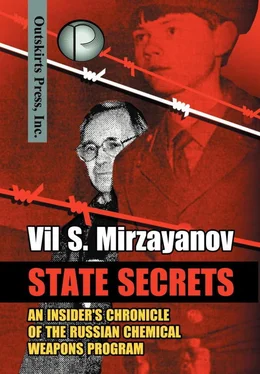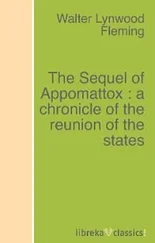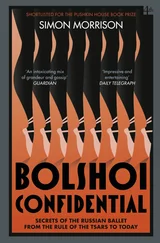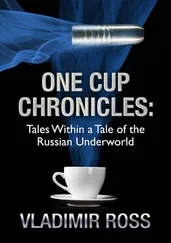Since I moved to the U.S., I have answered many questions posed by correspondents on subject of the Gulf War veterans. [76] For instance, Howard T. Uhal, ex-Clemson University, Clemson, SC, USA, “Soviet Chemical Warfare Agents Novichok and Substance 33: Were They Used During the Persian Gulf War?” http://www.nbcdefence.net/nore/novi_1.htm
Many of them are currently ill with an unknown disease, accompanied by symptoms consistent with poisoning by chemical agents. Official statements say that Iraq didn’t use the chemical weapons it possessed against the US Army. At the same time we know that Iraq had experience in using chemical weapons in the war against Iran and also against its own Kurdish citizens, shortly before the events in the Persian Gulf. I have no reason not to trust this version because the open use of chemical weapons against the well-equipped US Army could not have passed unnoticed.
Numerous UN inspections in the defeated territory of Iraq showed that there were no more stockpiles of chemical weapons. They stated that they were partially destroyed before the American intervention in Kuwait and the invasion of Iraq in 1991. Ultimately it seems clear that the American military chemists carelessly destroyed a large arsenal of Iraqi chemical weapons in the open air with crude explosions. Such a barbaric way of destroying chemical weapons is not effective, and a considerable fraction of the chemical agents would have remained intact. When chemical agents are exploded in this way, what remains mixes with solid particles (dust, sand, and products of combustion), and results in the strong contamination of the affected area. Adsorbed chemical agents can “live” on the surface of solid particles indefinitely, without changing their chemical composition. Moreover, highly toxic yet very stable pyrophosphonates are produced, at the high temperatures of the explosions of phosphoorganic agents. Given the climatic peculiarities of the Persian Gulf with its dry air, and its plentiful sand and dust which could be carried a long distance from the place of chemical destruction, we may presume that the American troops could have been exposed to the remnants of the “destroyed” chemical agents.
Finally, I would like to note that Human Rights Watch conducted an expedition in 1993 to the Kurdish village where the Iraqi regime had used sarin against peaceful inhabitants. There, they took some samples two years after the gas attack, and almost a year after samples had been taken from the graves of the victims. It was proven that micro-concentrations of sarin were found there. For the first time in the world and in the practice of scientific research, it was demonstrated that even such a relatively unstable chemical compound as O-isopropylmethyphosphonfluaridiate (sarin) could remain intact under the ground for a long time. [77] Human Right Watch President Ken Anderson’s private letter to author, 1996.
Determination of adsorbed compounds is extraordinarily difficult, and it requires special laboratory research. I don’t know whether or not such analyses were conducted in the field laboratories of the US Army or what their results might have been. If an ion mobility spectrometer was used, which was the main field instrument of the US Army, it is probable that chemical agents were not discovered in solid micro-particles. This device is designated for the determination of chemical agents in the gaseous phase. It has a relatively low sensitivity and can’t record those small concentrations which don’t kill people, but still are hazardous to the health.
Additionally, this device has very low selectivity. That means it is difficult to determine which molecule it has finally registered. That is why it had to be preliminarily adjusted for registering known compounds, which appear some time after the device starts operating, if they are present in the analyzed air. Each compound has its characteristic time of display. If the device gives a signal with a characteristic time that doesn’t correspond to the time for which it is adjusted, the signal is discarded as interference.
I think that during the Persian Gulf conflict, these spectrometers were adjusted for detecting mustard gas, sarin, and VX gas because there was information that Iraq possessed these kinds of chemical agents. Unfortunately, the US intelligence didn’t take into consideration the fact that Iraq couldn’t produce the American agent VX gas. It is highly likely that Iraq had the Soviet agent Substance 33, which is analogous to VX gas, but has different physical and chemical properties. It is also important to point out that Substance 33 has a different characteristic time of display on an ion mobility spectrometer. This means that if American soldiers were exposed to Substance 33, chemical specialists from US intelligence agencies couldn’t register it in the air. I can’t claim with confidence that Iraq had Substance 33, but I do know that modern Soviet chemical weapons were delivered to the Middle East in the 1980s. A retired colonel who participated in this operation told me about it. It is not difficult to guess where these weapons could have been shipped to, especially if we take into consideration which friends the Soviet Union had in this region, at that time.
Another serious problem that the American soldiers who have been to the Middle East may have been subjected to is the possibility of a deferred effect of low level exposure of chemical agents. When concentrations are low, the effect of these substances won’t be discovered during immediate exposure, as there are no immediate symptoms consistent with exposure to large concentrations.
The bosses of the military-chemical complex in Soviet Union were constantly pushing their scientists, aggressively giving the impression that chemical war could break out any day. The more successful were the negotiations in Geneva, the more intensive became the testing of new weapons carried out at the test site near Nukus. As a result, the Soviet army officially accepted “Novichok” as a weapon. This means that for the first time in the history of the chemical arms race, the Soviet Union took possession of its own chemical weapon, instead of borrowing one from a probable opponent. By that time the major parameters of the CWC had already been determined, and naturally “Novichok” wasn’t on the list of prohibited and controlled substances. If we consider those circumstances, we can better understand Director Petrunin’s boastful statement of about the “epoch-making success”.
Those were the circumstances under which I finally had to make a decision regarding my future.
And I made a resolute step…
CHAPTER 13
I’m Quitting the Party
On May 4 thof 1990, I submitted my resignation notice to the Party Committee, officially leaving the C.P.S.U. I wrote that the C.P.S.U. is a criminal organization which doesn’t have the right to be reorganized, so I was officially severing all my ties with it. It was the first statement of this kind in the history of GOSNIIOKhT.
After this the events evolved rapidly. On June 7th of 1990 a decree was issued about transforming the PD ITR Department back into the PD ITR Sector, with fewer employees. I was transferred to the Laboratory for Elemental Analysis, in the capacity of “leading research scientist”. Yuri Skripkin became my immediate supervisor. He had appeared at the institute from time to time, but he was spending most of his time in Geneva at the negotiations. Skripkin was really a narrow-minded sycophant. Petrunin was well aware of my attitude, and he deliberately transferred me to Skripkin’s subdivision as retribution for my political activity.
By that time I had become one of the co-chairmen of the Democratic Russia Movement (DDR) at GOSNIIOKhT. Almost every day we issued our agitation leaflets and posted them in prominent places, so people would know the truth about the events that were taking place in the U.S.S.R. Often GOSNIIOKhT supporters of the DDR were sent, under our leadership, to different meetings and demonstrations, in support of the DDR and Boris Yeltsin, whom everybody loved at that time.
Читать дальше












